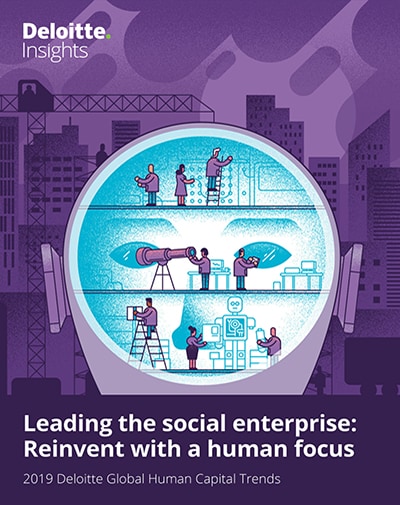
Rewards: Closing the gap 2019 Global Human Capital Trends
8 minute read
11 April 2019
With wage growth lagging behind inflation, many organizations are turning to noncash perks and programs to help drive worker retention and performance. But perks and pay aren’t what matter the most.
Rewards programs are falling behind both internal and external expectations. For workers, rewards mean more than money. They are looking for personalized rewards that meet their needs—and yet most organizations have been guessing and don’t know what their people want or value. Meanwhile, rising social pressures on organizations, driven in part by disparities in wealth and the gains from economic growth, mean more organizations need to account for how their own pay and rewards systems stack up against broader worker and societal expectations. In the domains of learning, leadership, teams, and career development, rewards have to be adjusted to drive the desired outcomes. There are gaps and growing frustrations across the board.
Learn more
Listen to the related podcast
View 2019 Global Human Capital Trends
Download the Deloitte Insights and Dow Jones app
Download the full report or create a custom PDF
Deloitte’s 10th annual Global Human Capital Trends Report is coming soon. Get it first by signing up!
As organizations compete for talent by touting organizational purpose, the workforce experience, career growth and fulfillment, and a wide variety of development programs, one critical component of the equation has fallen behind: rewards. This year, only 33 percent of respondents to our Global Human Capital Trends survey felt that their organizations were ready or very ready to address this issue, and only 11 percent of respondents believed that their rewards strategy was highly aligned with their organization’s goals (figure 1). Why is this area of business so hard to manage?

First, let’s consider the economy. It has now been 10 years since the global financial crisis, and many economies around the world have recovered.1 Corporations are reporting record profits,2 and in the United States, the unemployment rate fell to its lowest level in nearly five decades.3 Globally, many advanced economies, with a few exceptions, are also seeing unemployment numbers lower than in a decade or more.4 In 2018, Japan, the United Kingdom, Germany, and others saw their unemployment rates fall to lows not seen in years;5 and China’s unemployment rate hit 3.8 percent.6
Wages, on the other hand, are not keeping up with inflation, despite a small uptick at the end of 2018.7 Why aren’t wages growing with the economy? Our research shows that even in today’s highly competitive labor market, many organizations are reluctant to raise wages, with many extending noncash benefits to their workers instead. The well-being market, for example, is now a US$45 billion industry, and organizations are increasing spending on well-being by more than 7 percent this year.8 Organizations have offered flexible work hours, free lunches, unlimited vacation, and many other fringe benefits in efforts to make the workplace better. It seems that employers are willing to throw almost anything at their people to try to improve the workforce experience, as long as it doesn’t involve above-market raises in base pay.
We believe that many organizations are stuck in old-fashioned thinking: They see labor as a cost, not an asset, so they keep wages and associated spending on labor down.9 This philosophy might help organizations meet short-term financial targets. But as our global survey shows, the need to reskill people, restructure work, and improve the workforce experience is now paramount. This means that a broader view of rewards is becoming more important than ever as organizations look for effective ways to motivate their people. Increasingly, it makes good business sense to view all human capital spending as an investment, not an expense, and rewards are no exception.
Rewards to relationships
When we ask workers what’s important to them, the No. 1 answer is not money but the value of the work to them.10 A recent study that asked 2,400 professionals what inspired them most at work found that “the nature of the work itself” came in first, followed by “the ability to learn, grow, and progress.”11 This shift from rewards to relationships is critical to creating and embedding a workforce experience that stands alone as a differentiator in attracting and retaining the high talent workers of tomorrow (figure 2).

And this mindset around the workforce experience doesn’t just apply to full-time employees. Respondents to this year’s survey ranked compensation, flexibility, learning and development, and health and well-being benefits as the most important rewards in engaging the alternative workforce. It is critical for organizations to decide how to apply rewards practices not only to full- and part-time workers but also to gig workers, contractors, and crowdsourced talent who fall outside the traditional bounds of the employer-worker relationship. With the expanding challenges of maintaining compliance with labor market regulations and expectations, however, it’s easy to see why many organizations have struggled to achieve harmony between their rewards strategies and the greater range of worker types (figure 3). Most haven’t explored the issue in depth.

Best fit, not best practice
Just like the shift in the composition of the workforce, almost nothing about work and workplaces is the same as it used to be. People are looking for different things from their jobs beyond a paycheck, a retirement plan, and insurance. The workforce and its needs are more diverse. And above all, workers today can easily search employer reviews and ratings, find and compare rewards offerings across organizations, and decide for themselves their relative value. As a result, the old, standard method of determining the competitiveness of rewards—benchmarking compensation and benefits by industry and geography—holds little weight. Formal benchmark data quickly becomes outdated, which essentially means organizations are looking at where someone else has been to determine where they should go next.
Rather than rely on benchmarking, we believe that organizations should ground their rewards strategies in their organization’s unique culture and objectives and focus on curating employment brands that highlight how their rewards are different from those of their competitors. For example, organizations that need to attract large numbers of highly educated early-career workers might promote its innovative approach to helping employees deal with student debt. An organization with a business model built on agility, meanwhile, might highlight its frequent compensation review cycles and agile rewards offerings compared to organizations with a more typical year-end process.
Whatever the design is, understanding one’s own workforce and designing rewards accordingly is the first step to providing rewards that not only motivate performance but encompass the broad workforce experience organizations are trying to create. That said, staying attuned to workers’ expectations and needs can prove a challenge: In this year’s survey, respondents identified “Not understanding what’s most important to employees” as the top barrier to changing their organization’s rewards strategy (figure 4).

Starting from a refreshed slate
The frequent lack of alignment between organizational strategy and rewards means that many organizations must step back and refresh their rewards approach. The advantage of getting this right—of providing the best rewards for an organization’s workers—is particularly apparent now, when the labor market is tight and skilled workers are scarce. Providing the right rewards will enable organizations to retain them and keep them producing at high levels.
To understand what rewards are “right” for a given organization’s workers may require greater involvement from the business. For instance, at the cybersecurity company Avast, the business leaders have primary responsibility for total rewards, owning the rewards budget and allocating it as they see fit to encourage retention, worker performance, and other desired outcomes. HR plays a supporting, coaching role, offering advice and guidance but leaving final rewards decisions to the business.12
In other cases, organizations have gone directly to their workers to find out what they want. N6A, a public relations firm, offers traditional benefits to its workers, but now also allows workers to customize their rewards in a program called Pace Points. The perks and rewards workers value most—whether cash, health club membership, travel, housing, nutrition and meal services, or other items and services—can be obtained by earning “Pace Points” for individual, team, and companywide achievements.13
And these organizations aren’t alone. In fact, the latest research by Bersin™ tells us that high-performing organizations are six times more likely to use data and analysis to understand the rewards preferences of their workers compared with their lower-performing counterparts.14
But transparency needs to go both ways. While understanding what workers want is one part of the equation, the other part of a winning rewards strategy is to make sure that people understand what they’re getting. Here, organizations need to do a better job of explaining their rewards to workers—and to articulate that rewards may change as people migrate through different roles, sometimes up, sometimes down, and sometimes across the enterprise. Such transparency about pay runs counter to common practice: Only 18 percent of the respondents to our survey believe that they have a “very transparent” model to communicate pay information. But as risky as being open about pay and other rewards may seem, it is an essential part of the dialogue around rewards that organizations should maintain with their workers to understand their needs and articulate the organization’s efforts to meet them.
In the world of the social enterprise, where workers are seeking deeper meaning in their work and organizations are striving to create a greater human connection with their workers, rewards can either be an incredible motivator or a topic of contentious debate. To help avoid the latter, organizations must expand their view of rewards, engage their workers, and enter a new world of work where perks and pay are just the beginning.

© 2021. See Terms of Use for more information.
Explore the collection
-
From employee experience to human experience Article5 years ago
-
Accessing talent Article5 years ago
-
Talent mobility Article5 years ago
-
HR cloud Article5 years ago
-
Looking ahead Article5 years ago
-
2019 Global Human Capital Trends Collection





















